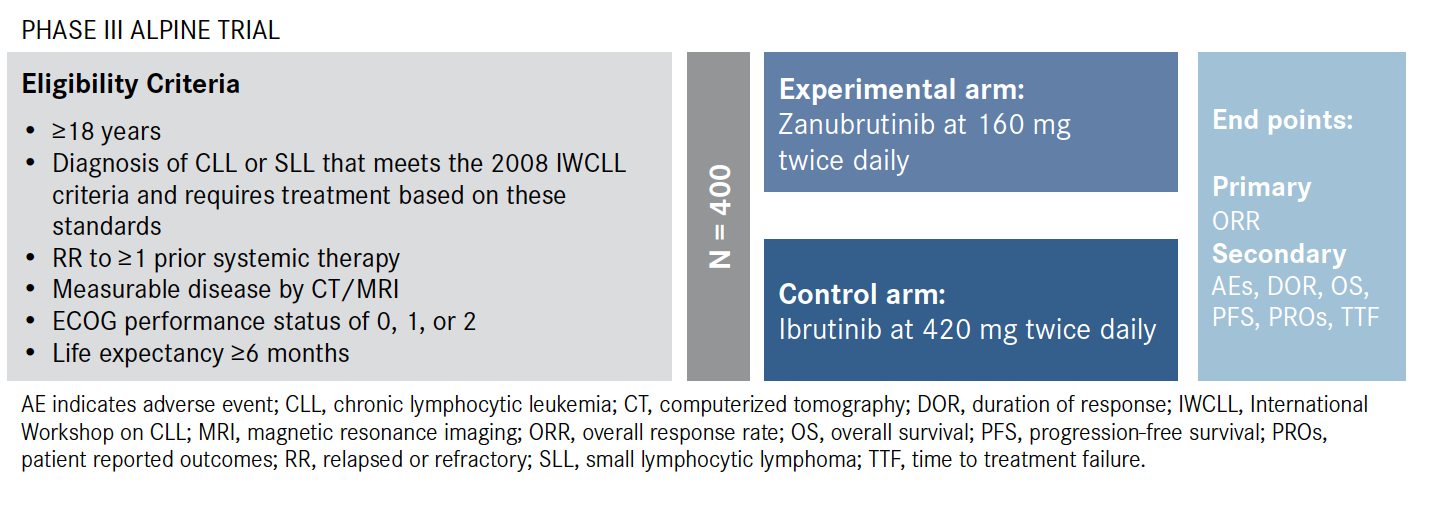Publication
Article
Oncology Live®
Zanubrutinib Faces Off Against Ibrutinib in CLL Trial
Author(s):
Armed with the knowledge that inhibition of the Bruton tyrosine kinase is an effective approach in B-cell malignancies, investigators will explore the efficacy of the second-generation BTK inhibitor, zanubrutinib, in 2 leukemia and lymphoma subtypes.
Jennifer R. Brown, MD, PhD
Armed with the knowledge that inhibition of the Bruton tyrosine kinase (BTK) is an effective approach in B-cell malignancies, investigators will explore the efficacy of the second-generation BTK inhibitor, zanubrutinib (Brukinsa), in 2 leukemia and lymphoma subtypes.1
The phase III ALPINE trial (NCT03734016) is comparing zanubrutinib with the BTK inhibitor ibrutinib (Imbruvica) in 400 patients with relapsed or refractory (RR) chronic lymphocytic leukemia (CLL) or small lymphocytic lymphoma (SLL). Zanubrutinib capsules are currently indicated for the treatment of adult patients with MCL who have received ≥1 prior therapy. The FDA granted zanubrutinib an accelerated approval in this setting in November 2019. In a statement announcing zanubrutinib’s clearance in MCL, BeiGene, the developer of zanubrutinib, said the agent’s continued approval for this indication “may be contingent upon verification and description of clinical benefit in a confirmatory trial.2
Investigation Beyond MCL
The objective of the ALPINE study is to discern whether or not zanubrutinib elicits noninferior or superior responses versus ibrutinib, a standard of care in CLL and SLL that has been associated with high response rates but also a high incidence of treatment discontinuation, according to Jennifer R. Brown, MD, PhD, an ALPINE study investigator and director of the CLL Center at Dana-Farber Cancer Institute in Boston, Massachusetts.1
“Ibrutinib discontinuation is estimated to be as high as 25% to 30%; Because of that, many patients aren’t able to derive full benefit from ibrutinib,” said Brown, who is also a member of the trial steering committee.
Compared with ibrutinib, zanubrutinib demonstrated greater selectivity for BTK with fewer off-target effects. Toxicities are the most common reason for the discontinuation of ibrutinib therapy in patients with CLL. “We think that some of the adverse events [AEs] seen with ibrutinib are related to off-target effects,” Brown said. Greater selectivity in BTK inhibition could lead to fewer off-target effects, and therefore lower toxicity.3 Findings from a first-in-human study of zanubrutinib suggest that zanubrutinib may be less toxic than ibrutinib, but the number of patients treated thus far is relatively small, according to Brown.
Figure. Zanubrutinib Evaluated in CLL, SLL (Click to Enlarge)

Patients with RR CLL and SLL will be randomized to receive either singleagent zanubrutinib at 160 mg twice daily or ibrutinib monotherapy at 420 mg once daily. The primary end point is overall response rate (ORR) determined by independent central review. Secondary end points include AEs, duration of response, overall survival, progression-free survival (PFS), patient-reported outcomes, and time to treatment failure (Figure).
Investigators will stratify patients by age (<65 years vs ≥65 years), refractory status, geographic region, and the presence or absence of deletion in chromosome 17p [del(17p)] or TP53 mutations.1 In CLL, del(17p) and TP53 are 2 of the strongest predictive markers of treatment response.5
These aberrations correlate with decreased survival and predict impaired response to chemoimmunotherapy in patients with CLL.
“We know that del(17p) certainly confers resistance to chemoimmunotherapy of any type,” Brown said. She added that the advent of novel agents including BTK inhibitors, the BCL-2 inhibitor venetoclax (Venclexta), and PI3K inhibitors made achieving higher response rates in patients with del(17p) a possibility. However, “the PFS is still generally shorter than it is for the rest of the population without these deletions,” Brown said.
Data from the phase III SEQUOIA trial (NCT02923921) and updated results from the phase I/II AU-003 study (NCT02343120) were presented at the 2019 American Society of Hematology Annual Meeting. In SEQUOIA, frontline zanubrutinib led to a high ORR (92.7%; 95% CI, 86%-96.8%) in 109 treatment-naïve (TN) patients with del(17p) CLL or SLL.6
After 29.5 months of follow-up, the ORR was 100% among AU-003’s 22 TN patients with del(17p) CLL or SLL. This consisted of all partial responses (n = 3). The 12- and 24-month PFS rates were 95% and 97%, respectively.7
In the RR del(17p) group, the ORR was 92.3% with 1 complete response (CR; 7.7%). The 12-month PFS was 97% and the 24-month PFS was 91%.7
Early findings from AU-003 were presented at the 2017 International Conference on Malignant Lymphoma; updated data were later published in Blood.
The first stage of the first-in-human trial used a 3 + 3 dose-escalation design to evaluate the optimal dose of zanubrutinib in 17 patients with RR B-cell cancers. The agent was administered in doses ranging from 40 mg once daily to 320 mg once daily, or 160 mg twice daily. No dose-limiting toxicities were observed.3
The second part of the study was an expansion phase that included diseasespecific cohorts such as mantle cell lymphoma (MCL) and Waldenström macroglobulinemia. TN patients with CLL and SLL were also included in this subsequent phase and received zanubrutinib at 320 mg once daily or 160 mg twice daily.3 A total of 94 patients with CLL and SLL participated in this second phase.
At a median follow-up of 13.7 months, 89 patients (94.7%) with CLL or SLL remained on the study and 78 were evaluable for efficacy. The ORR was 96.2% (95% CI, 89.2%-99.2%) and the estimated PFS at 12 months was 100%. Notably, 2 patients (2.6%) achieved a CR and 63 patients (80.8%) had a partial response.3
Response rates were similar among TN patients and those with RR disease. For example, the ORR was 100% in the TN population and 94.6% in the RR group. The CR rate was 4.5% and 1.8%, respectively.3
In addition to showing early signs of efficacy, zanubrutinib also had a low incidence of serious toxicities, investigators said. Most toxicities were grade 1/2. Neutropenia was the only grade 3/4 AE seen in >2 patients, and 1 patient had grade 3 subcutaneous hemorrhage.3 Overall, findings suggested that zanubrutinib monotherapy can induce deep responses in patients with TN or RR CLL and SLL, supporting further clinical study of the agent.3
Broader exploration of zanubrutinib has ensued. Beyond ALPINE, zanubrutinib monotherapy is being compared with ibrutinib in the phase III ASPEN trial (NCT03053440), which is evaluating the agent in patients with Waldenström macroglobulinemia. Other arms of SEQUOIA continue to enroll, including an arm comparing zanubrutinib with bendamustine plus rituximab (Rituxan) for the same patient population.
Zanubrutinib is also being studied in combination with the investigational humanized IgG4 anti—PD-1 monoclonal antibody, tislelizumab (BGB-A317), in an open-label phase Ib trial and with obinutuzumab (Gazyva) in a phase II trial.8
In the ALPINE study, investigators are hopeful that zanubrutinib will move expeditiously down the path to approval for RR CLL and SLL, broadening the armamentarium. “There’s certainly a need for BTK inhibitors that are more tolerable, allowing patients to [continue and complete] treatment,” Brown said.
ALPINE will enroll patients at more than 100 sites worldwide.
References
- Hillmen P, Brown JR, Byrd JC, et al. ALPINE: phase III zanubrutinib (BGB-3111) versus ibrutinib in patients with relapsed/refractory (R/R) chronic lymphocytic leukemia/small lymphocytic leukemia (CLL/SLL). J Clin Oncol. 2019;37(suppl 15):TPS7572. doi: 10.1200/ JCO.2019.37.15_suppl.TPS7572.
- U.S. FDA grants BeiGene’s BRUKINSA™ (zanubrutinib) accelerated approval to treat adult patients with mantle cell lymphoma who received at least one prior therapy [news release]. Cambridge, MA: BeiGene; November 14, 2019. brukinsa.com/ press-release.pdf. Accessed November 25, 2019.
- Tam CS, Trotman J, Opat S, et al. Phase 1 study of the selective BTK inhibitor zanubrutinib in B-cell malignancies and safety and efficacy evaluation in CLL. Blood. 2019;134(11):851-859. doi: 10.1182/blood.2019001160.
- Zanubrutinib. National Cancer Institute Drug Dictionary website. cancer.gov/publications/dictionaries/ cancer-drug/def/btk-inhibitor-bgb-3111. Accessed November 25, 2019.
- Campo E, Cymbalista F, Ghia P, et al. TP53 aberrations in chronic lymphocytic leukemia: an overview of the clinical implications of improved diagnostics. Haematologica. 2018;103(12):1956-1968. doi: 10.3324/haematol. 2018.187583.
- Tam CS, Robak T, Ghia P, et al. Efficacy and safety of zanubrutinib in patients with treatment-naïve chronic lymphocytic leukemia (CLL) or small lymphocytic lymphoma (SLL) with del(17p): initial results from arm C of the Sequoia (BGB-3111-304) trial. Presented at: 2019 ASH Annual Meeting; December 7-10, 2019; Orlando, FL. Abstract 499. bit.ly/2rkuTqP.
- Cull G, Simpson D, Opat S, et al. Treatment with the Bruton tyrosine kinase inhibitor zanubrutinib (BGB-3111) demonstrates high overall response rate and durable responses in patients with chronic lymphocytic leukemia/ small lymphocytic leukemia (CLL/SLL): updated results from a phase 1/2 trial. Presented at: 2019 ASH Annual Meeting; December 7-10, 2019; Orlando, FL. Abstract 500. bit.ly/355AShl.
- Zanubrutinib. BeiGene website. beigene.com/science- and-product-portfolio/pipeline/zanubrutinib. Accessed November 25, 2019.
Based on preclinical data, ALPINE investigators hypothesize that zanubrutinib is a more specific and more tolerable BTK inhibitor than ibrutinib that may also have enhanced efficacy. Like ibrutinib, zanubrutinib covalently binds to cysteine 481 in the adenosine triphosphate—binding domain of BTK, preventing the growth and diffusion of malignant B-cells that overexpress BTK.3,4 The investigational agent also has favorable pharmacokinetic properties that maintain blood levels of the drug throughout the dosing interval.3









